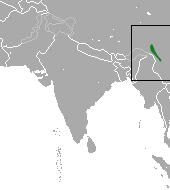Black snub-nosed monkey
| Black snub-nosed monkey[1] | |
|---|---|
 | |
| Scientific classification | |
| Kingdom: | Animalia |
| Phylum: | Chordata |
| Class: | Mammalia |
| Order: | Primates |
| Suborder: | Haplorhini |
| Infraorder: | Simiiformes |
| Family: | Cercopithecidae |
| Genus: | Rhinopithecus |
| Species: | R. bieti |
| Binomial name | |
| Rhinopithecus bieti (Milne-Edwards, 1897) | |
 | |
| Black snub-nosed monkey range | |
The black snub-nosed monkey (Rhinopithecus bieti), also known as the Yunnan snub-nosed monkey, is an endangered species of primate in the family Cercopithecidae. It is endemic to China,[1] where it is known to the locals as the Yunnan golden hair monkey (滇金丝猴) and the black golden hair monkey (黑金丝猴). It is threatened by habitat loss.[2] It was named after Bishop Félix Biet.
Characteristics
The black snub-nosed monkey is a large, stocky, and well-furred primate belonging to the leaf Colobinae subfamily. Despite its morphological distinctiveness and noteworthy biology this is one of the lesser known primate species. In recent years, however, knowledge about the behavior and ecology of the black snub-nosed monkey has grown. Lack of information is mainly a result of difficult research conditions due to the monkey's semi-nomadic lifestyle, elusive nature and inhospitable habitat with extremely steep hillsides, impenetrable bamboo thickets, freezing winter climate with snow as well as damp and foggy summers with minimum visibility.
This species has a highly restricted distribution in the bio-diverse Nujiang Langcang Gorge alpine conifer and mixed forests of the Yun Range, part of the greater Hengduan Mountains.[3] Only 17 groups with a total population of less than 1,700 animals have survived in northwest Yunnan and neighboring regions in the Autonomous Prefecture of Tibet. Group size is small, typically only 20 to 60; groups of over 100 have never been observed. The territory of each group varies from 20 to 135 square km.[4]
History
The black snub-nosed monkey was almost completely unknown until the 1990s. The fact that no single zoo outside China has ever kept the black snub-nosed monkey in captivity has contributed to the enigmatic status of this species. The black snub-nosed monkey lives in one of the most extreme environments of any nonhuman primate. Its habitat is either pure temperate coniferous forest or deciduous/evergreen broadleaf and coniferous forest.[5] The highest recorded altitude of a group of this species is 4700 m.[3] The black snub-nosed monkey lives in very large super-groups which are made up of single-male core families or harems.[6] The monkey moves fast and far in a cohesive group and covers vast areas in search of lichens and other seasonally available food items.
Reproduction
The reproduction cycles of black snub-nosed monkey is generally similar to that of golden snub-nosed monkeys, except the time of birth is often two to three months later due to colder climate.[7] Like most primates, the snub-nosed monkey gives birth at night, making it difficult for researchers to observe. A rare observation of a daytime birth found a multiparous female assisting another female in the birthing process, similar to human midwifery practice.[8]
See also
References
- 1 2 Groves, C.P. (2005). Wilson, D.E.; Reeder, D.M., eds. Mammal Species of the World: A Taxonomic and Geographic Reference (3rd ed.). Baltimore: Johns Hopkins University Press. p. 173. ISBN 0-801-88221-4. OCLC 62265494.
- 1 2 Bleisch, W. & Richardson, M. (2008). "Rhinopithecus bieti". The IUCN Red List of Threatened Species. IUCN. 2008: e.T19597A8986243. doi:10.2305/IUCN.UK.2008.RLTS.T19597A8986243.en. Retrieved 11 January 2018.
- 1 2 Long, Y. C.; Kirkpatrick, R. C.; Zhong, T.; Xiao, L. (1994). "Report on the distribution, population, and ecology of the Yunnan snub-nosed monkey (Rhinopithecus bieti)". Primates. 35 (2): 241–250. doi:10.1007/BF02382060.
- ↑ Long, Y. & Wu, R. (2006). "Population, home range, conservation status of the Yunnan snub-nosed monkey (Rhinopithecus bieti)". Abstracts of the China Fusui International Primatological Symposium: 10–11.
- ↑ Ding, W. & Zhao, Q. (2004). "Rhinopithecus bieti at Tacheng, Yunnan: diet and daytime activities". International Journal of Primatology. 25 (3): 583–598. doi:10.1023/B:IJOP.0000023576.60883.e5.
- ↑ Grüter, C. C. & Zinner, D. (2004). "Nested societies. Convergent adaptations in snub-nosed monkeys and baboons?". Prim. Rep. 70: 1–98.
- ↑ Kirkpatrick, R. C.; Long, Y. C.; Zhong, T.; Xiao, L. (1998). "Social organization and range use in the Yunnan snub-nosed monkey Rhinopithecus bieti". International Journal of Primatology. 19: 13–51. doi:10.1023/A:1020302809584.
- ↑ Ding, Wei; Yang, Le; Xiao, Wen (5 February 2013). "Daytime birth and parturition assistant behavior in wild black-and-white snub-nosed monkeys (Rhinopithecus bieti) Yunnan, China". Behavioural Processes. doi:10.1016/j.beproc.2013.01.006.
